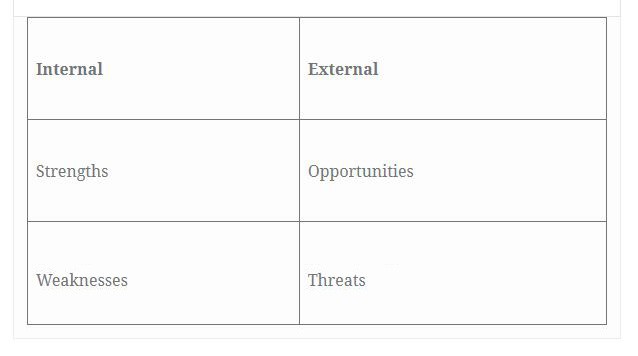What is a SWOT Analysis?
The purpose of a SWOT analysis is to gain a clear understanding of where you currently stand, so that you can create a realistic and actionable plan to move forward.
Effective planning — whether it be marketing planning, operational planning, strategic planning, etc. — begins with a solid understanding of your current state so that you can take an informed approach forward.
SWOT stands for strengths, weaknesses, opportunities, and threats.
Accordingly, a SWOT analysis consists of evaluating and measuring each of these areas as they are relevant to a particular project, or a business as a whole.
SWOT is a powerful strategizing tool that can help to paint a clear picture of where a business stands, how the business is different from others in the market, and how the brand should position itself against competitors.
The information that results from a SWOT analysis can then be conveniently shared with the primary stakeholders and decision makers at the organization.
Internal vs. External Perspectives of SWOT Analysis
SWOT analysis consists of both internal and external perspectives.
Strengths and weaknesses are considered to be internal perspectives.
Once SWOT analysis is performed, your goal should be to build on your strengths, and mitigate your weaknesses.
Contrastly, opportunities and threats are considered to be external perspectives.
Your goal should be to invest in opportunities, and monitor any possible threats to your plan.
It’s important to maintain an understanding of the differences between these internal and external perspectives while performing a SWOT analysis.
The goal of performing SWOT is to develop a comprehensive understanding of your business. This entails understanding what you can control (the internal perspective) versus what you can influence, but cannot control (the external perspective).
How to Perform a SWOT Analysis
Getting Started
The easiest way to get started with SWOT analysis is to break things up into four defined quadrants on a whiteboard or piece of paper. Your quadrants should look like this:

SWOT analysis is best performed in a collaborative group.
If you are mapping your thought processes on a whiteboard using the format above, the goal should be to brainstorm and drop a list of bullet points into each quadrant.
Dropping in Data
The next step that will allow you to bring your SWOT analysis to the next level is tracking down relevant data, and dropping that data into relevant quadrants of your SWOT as well.
Where can you find this data?
Well, when it comes to obtaining data in regard to internal perspectives, you can leverage executives, board members, employees, customers, or a thorough review of your KPI’s and if you’ve been achieving them.
You could consider holding one-on-one interviews with your executives and board members, or distributing employee surveys or customer surveys.
If time is a factor, you should prioritize gathering data from employees and customers over gleaning insights from executives and KPI data.
For data regarding external perspectives, you can leverage trends that you’ve identified in your industry to provide insights into opportunities or threats. Industry associations or analyst firms typically have reports founded on data that highlight specific trends and benchmarks.
You can also look at your target market, or the market that you serve. You can leverage sources such as the US Census Bureau to receive data on markets that are relevant to your business.
It’s also imperative to know what your primary competitors are doing, and how they are approaching the market that you share with them. This can be accomplished via a competitor analysis.
Again, if your SWOT analysis is time sensitive, consider prioritizing the obtainment of industry and competitive data.
Communicating Your Findings
Once you’ve used the processes outlined above to build out your SWOT analysis by adding as much detail to each quadrant as possible, it’s time to share your findings with the relevant parties within your company.
Ideally, a SWOT analysis should fit on one page so that someone can digest it quickly, and get to the primary storyline that the analysis frames.
This will enable executives and other relevant parties to gain a detailed understanding of where you currently stand, and areas where you can potentially improve, all at a glance.
You should now have all of the information you need to conduct a thorough and effective SWOT analysis.